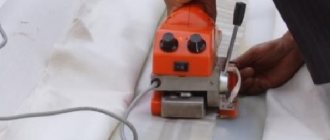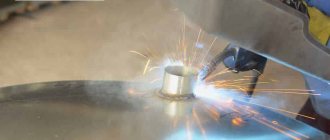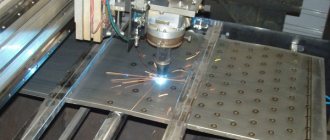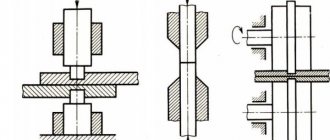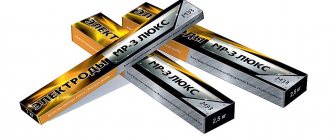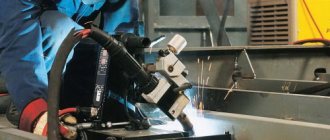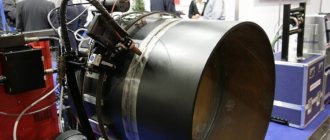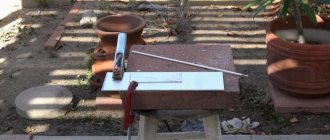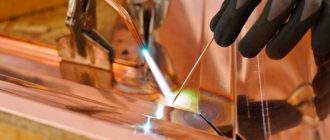Ultrasonic welding of plastics is a common method for welding polymers, such as polypropylene products. Ultrasonic welding of plastics has firmly taken its place in the industry, as it can reduce costs while increasing the efficiency and quality of welding work.
In this article we will look in detail at what ultrasonic welding is, what equipment is needed for ultrasonic welding of plastics, and what are the advantages of this method.
Operating principle of ultrasonic welding
So, what is the ultrasonic welding method? In simple terms, ultrasonic equipment generates mechanical vibrations, which it then converts into thermal energy, which is used to make connections. This process is also called "utilization of conversion energy", in our case the conversion of mechanical energy into thermal energy.
The process itself roughly consists of two stages. At the first stage, thermal energy obtained as a result of the transformation of mechanical vibrations and pointwise directed to the welding site increases the diffusion of molecules in plastic parts. After this, the boundaries of the welded parts begin to melt and bond together. At the second stage, the boundaries of the welded parts cool down and form a strong seam. This is a rough description of the operating principle of ultrasonic welding. Next we will look in more detail at how such compounds are obtained.
Operating principle
The essence of the ultrasonic welding method is that the generator generates electrical oscillations with a frequency of 20-50 kHz, which belong to the ultrasonic field. Then they are converted into mechanical vibrations of an instrument called a waveguide. The pneumatic cylinder included in this device forces the welded parts of the product to be pressed against each other. In this case, vibrations are transmitted to the welding zone.
The polymers being joined are subject to deformation. Diffusion begins between them - the penetration of molecules of one product into another, or rather into its intermolecular spaces. This process is reciprocal. Plastic parts are connected.
To ensure uniform distribution of the molten material in the weld, after the ultrasonic effect is turned off, the parts remain pressed against each other until they cool completely. The most commonly used method for this is the lap joint.
Ultrasonic welding can be performed according to the principle of seam formation, spot welding and along the perimeter.
Ultrasonic welding of polypropylene and other types of plastics can be performed in this way.
The essence of obtaining seams with ultrasound
Classic ultrasonic welding differs significantly from the metal welding that many are accustomed to. Welding metal requires an extremely high melting temperature, but in the case of ultrasound, all that is needed is the energy emanating from the ultrasonic wave and a simultaneous mechanical effect on the intended location of the future weld. Therefore, there is no need to use additional consumables, such as electrodes or wire.
The welder connects a generator to the ultrasonic welding equipment, thanks to which ultrasonic vibrations are generated. These vibrations are converted into mechanical ones, this happens using a special converter. Then a waveguide is connected, which oscillates perpendicular to the weld. Due to this, the converted vibrations directly fall into the intended location of the future welded joint, and static and dynamic pressure is also generated. Static and dynamic pressure is directed perpendicular to the parts, with each type of pressure performing its own function. Dynamic pressure allows you to achieve the required melting temperature for a particular type of plastic, and static pressure helps to form a strong connection.
Thanks to all these features, even metal and plastic can be joined using ultrasonic welding, although their melting temperatures are significantly different. Plastic can also be combined with any other material that can withstand ultrasonic welding.
What are the parameters of ultrasonic welding equipment?
To work with ultrasonic equipment, you should familiarize yourself with the basic parameters that can be adjusted depending on your work. So you can adjust:
- The amplitude of vibrations of the waveguide end (this parameter allows you to adjust the welding time and the strength of the finished seam)
- The frequency of electrical oscillations and the force of pressure of the waveguide on the plastic.
- Pulse duration (this parameter adjusts the welding speed).
- Statistical (welding) pressure (this parameter depends on the amplitude of vibrations and affects the quality of the finished seam).
There are also additional options. For example: the preheating temperature of the part, parameters taking into account the size and shape of the parts, and many others.
For each individual type of plastic and seam that needs to be obtained, its own individual parameters are set. Their combination is called the welding mode. The optimal welding mode for certain parts in industrial conditions is selected only after research. Specialists in the laboratory make connections in various modes and test the seams for tightness, reliability and other qualities. Of course, if you plan to use ultrasonic welding equipment for personal purposes, you won't be doing the research. But we still recommend practicing on small samples. Only through trial and error can you find the optimal parameters for each type of welding.
Ultrasonic welding of polyethylene
Ultrasonic welding is used in the manufacture of containers, various containers and pipes intended for storing food and other industrial products.
In most cases, when packaging products in plastic containers, the surfaces to be joined are contaminated with the product being packaged. Therefore, the use of welding methods other than ultrasonic is excluded in this case. Contamination of the welded surfaces by the packaged product imposes specific requirements on the ultrasonic welding process, since this affects the strength of the resulting welded joint. Surface contamination leads to a decrease in the strength of the welded joint.
In addition, when welding polyethylene products, one should take into account the storage features and previous processing of the products being joined, which also affects the strength and performance characteristics of the weld.
The use of preliminary heat treatment in the temperature range of 50–100°C has a slight effect on the strength of welded joints (the strength decreases by 5–9%, respectively, compared to the strength of samples welded without preliminary heat treatment).
With an increase in processing temperature to 115 °C, a decrease in strength by 17% is observed, and the welding duration increases by 2-3 s.
The aging of polyethylene under solar radiation significantly affects the quality of the weld. After 30 hours of irradiation with ultraviolet rays, a sample of unstabilized low-density polyethylene with a thickness of 0.7 mm ceases to be welded. Polyethylene stabilized with carbon black or paraffin ceases to be welded after 60 hours of irradiation.
Detailed classification
We have classified the ultrasonic welding method into several categories, which in turn have their own subtypes. So, ultrasonic welding of plastics is divided into:
- The principle of movement along the seam. It can be manual, when the welder himself directs the welding tool, or mechanical, when welding occurs using automatic equipment according to predetermined parameters. The mechanical method is more accurate than the manual one, but there is no way to quickly change the direction of the seam if necessary.
- The principle of energy supply. Can be bilateral or unilateral. One-sided is more intended for welding thick parts, and double-sided is more suitable for thin parts. But double-sided requires additional cooling.
- The principle of waveguide movement. It can be continuous, when the waveguide moves at a constant speed, or it can be discontinuous, making one short movement at specified intervals.
More generally, ultrasonic welding is divided into contact and transfer welding. Contact welding is needed to connect thin plastic parts (up to 2 mm). To make a seam, the parts are laid on top of each other with a slight overlap and the seam is made along it.
Transfer welding is used in all other cases, and also in those moments when the plastics being welded have high acoustic properties. The essence of transfer welding is the introduction of mechanical vibrations at certain points. In this case, energy is released in the amount necessary for the ultrasonic wave to propagate evenly. In this case, the seam is reliable and of high quality. Transfer welding is often used when welding soft plastics (which must first be frozen) or for butt seams on polystyrene, polyamide and polycarbonate parts.
Ultrasonic welding of polystyrene
Ultrasonic welding of polystyrene products is used for the manufacture of various containers and vessels, toys, sporting goods, as well as for packaging food products, medicines, cosmetics, etc. Depending on the shape of the product and the properties of the material, resistance and transfer welding or a combination of these methods is used . Each of the currently produced polystyrenes (block, suspension, emulsion and impact-resistant) has a different weldability - from the best for block to the worst for impact-resistant polystyrene.
When welding polystyrene products, one of the important factors influencing the process of forming welds is the quality of the surfaces being joined. A good geometric shape and proper surface preparation not only facilitate welding, but also help to increase the strength of the seam, increase the productivity of the process and allow one part of the welded product to be strictly fixed relative to another part.
The cutting of the edges can vary in shape, but basically one of the joined parts must have a protrusion that fits along the entire length into the corresponding groove of the other part (Fig. 20). The parts to be joined must have the smallest contact surface; therefore, the groove is made flat and the protrusion is sharp. The tip of the protrusion must contact the surface to be joined in a very small area, which is reduced almost to a line. This contributes to the concentration of mechanical energy on the protrusion, accelerating the process of heating and welding of plastics.
The best is the V-shaped groove of the welded edges, which is used to connect the parts shown in Fig. 20, a. A V-shaped protrusion is made on the upper part, and a V-shaped groove is made on the lower part. The height of the protrusion should be 0.05-0.030 mm greater than the depth of the groove. With this type of connection, better fluidity of the heated material under pressure is achieved and the seam has a good appearance.
When welding joints, it is necessary to provide tolerances for the fluidity of the softened polymer, which is squeezed out of the weld area, forming a flash. If burr is undesirable, special seam designs are used to avoid polymer splashes (see Fig. 20, 6 and c). The polymer, brought to a viscous flow state, must connect the two mating surfaces, filling a gap of several tenths of a millimeter.
Rice. 20. Types of cutting the edges of the welded surfaces of the product.
The bead line along the seam and the bead extending beyond the seam indicate that welding has occurred. In cases where the tightness of the product is required, it is necessary that the welded parts have a bead line. However, the bead line generally detracts from the appearance of the product and should therefore be avoided, especially on polished surfaces.
Improving the appearance is achieved by a stepped design of the working part of the waveguide, while the protrusion is made so that an influx is formed on the inside of the product. Small-sized parts of simple shape are welded using one contact of the waveguide with the product, and the waveguide is installed perpendicular to the surfaces to be welded along the axis of symmetry of the connection. If the part is complex and the length of the weld is significant, then the number of points and the location of the introduction of ultrasonic vibrations are determined experimentally.
The weldability of rigid plastics is greatly influenced by the storage conditions of the parts being joined. Long-term storage of parts before welding leads to a decrease in the strength of the welded joint. The strength of the joint decreases especially strongly when welding parts that have undergone long-term storage in atmospheric conditions. Thus, to obtain high-quality welded joints, welding must be done either immediately after casting the parts, or the cast parts must be stored in dark, cold rooms. Storing parts in atmospheric conditions in the presence of solar radiation is unacceptable.
The use of ultrasound for welding parts of children's toys made of polystyrene made it possible to completely eliminate the process of gluing with dichloroethane, toluene and other solvents, the use of which leads to significant air pollution. The use of ultrasonic welding increases labor productivity and production culture.
Advantages and disadvantages of ultrasonic welding
This welding method has many advantages, which is why it has become so popular in industry and beyond. Here are some of them:
- Provides high performance at relatively low cost.
- Allows you to obtain high-quality sealed seams that are resistant to mechanical stress on parts of any thickness.
- Makes it possible to carry out welding work on parts in any condition; the surface does not need to be pre-cleaned.
- Heat is released only at one specific point, so there is no chance of overheating the weld.
- Voltage is not supplied to the surface of the parts being welded, which prevents the formation of radio interference.
- A variety of seams can be performed, from spot repairs to continuous joining of parts on an industrial scale. In this case, there is no need to observe special conditions; ultrasonic welding can be carried out in any place where there is electricity.
- This method allows you to combine several tasks at once. For example, you can weld plastic and simultaneously apply some kind of polymer coating or cut.
- Any plastic can be welded together.
- If you accurately select the welding mode, you can achieve an almost invisible seam.
- There is no need to use consumables, glue or solvent, which can have a detrimental effect on the body.
But, like any welding method, there are some drawbacks:
- There is a particular need to use two-way energy supply due to the low power of the welding process.
- There is no single way to control the quality of the welded joint, because of this the work may turn out to be of poor quality.
As you can see, there are few shortcomings. But keep in mind that all the advantages of ultrasonic welding are available only if you set the mode correctly. If you are a beginner, we recommend choosing equipment that automatically determines the optimal welding mode.
If you intend to select the mode manually, then use the table below (here, as an example, parameters for welding plastic pipes). It shows the recommended settings. Over time, you will gain more experience and be able to choose the optimal mode yourself.
Advantages and disadvantages when working with plastics
When working with plastics, the following advantages of the method exist:
- high performance;
- low cost of surgery;
- tightness of seams on thick-walled workpieces;
- no need for surface preparation;
- no overheating;
- absence of electrical interference and electromagnetic radiation;
- compatibility of the operation with other operations of the technological process, spraying, cutting in other planes, etc.;
- versatility across types of plastics;
- lack of consumables and chemicals.
- aesthetics and invisibility of the seam.
Ultrasonic welding of plastics
There are also disadvantages:
- The low power of the emitter forces energy to be supplied from two sides.
- Difficulty in controlling seam quality.
The quality of the connection depends on the accuracy of the selection and stability of the installation parameters during operation.
Ultrasonic welding equipment
The ultrasonic equipment set consists of an ultrasonic generator, press, support, transducer, waveguide and welding tool. In this case, there are several main nodes that play a primary role. These include:
- Ultrasonic generator
The generator produces ultrasonic vibrations and then converts them into mechanical ones, while maintaining the same frequency. Also, using the generator, you can regulate the vibration speed and determine the method of transmitting ultrasonic energy.
- Converter
A converter (most often piezoceramic or magnetostrictive) in conjunction with a generator is responsible for converting electrical energy into mechanical energy and is used in devices with two-way energy supply. It is important to take into account that such equipment requires constant cooling, for example, water or air.
- Elastic vibration transformer
The elastic vibration transformer coordinates the operation of the converter and the waveguide, essentially being a connecting link. It is also capable of increasing the amplitude of oscillations from the end of the waveguide.
- Waveguide
The waveguide transmits mechanical energy and creates pressure at specific locations. An acoustic transformer can serve as a waveguide.
- Support
Support is necessary for reliable fixation of parts. In some cases, it is directly used for welding as an additional waveguide.
Additionally, the equipment can be equipped with a function for automatic or manual control of operating parameters. We recommend using this type of equipment because it allows you to get the job done with truly high quality. Only in this case can the maximum strength of the welds be achieved.
How does ultrasonic welding of plastics occur?
An ultrasonic generator produces electrical vibrations of ultrasonic frequency (20 - 50 kHz), converted by a piezoceramic converter into mechanical vibrations of a welding tool (waveguide or sonotrode). Under the action of a pneumatic cylinder, the waveguide presses the welded parts against each other and transmits vibrations to the ultrasonic welding zone. As a result, the polymers being welded are deformed and diffuse among themselves: amorphous materials pass into a viscous-flow state, and crystalline materials are heated to the melting temperature of the crystals. The ultrasound is turned off, and the parts are kept for some time under the pressure of the “cold” waveguide to evenly distribute the molten material in the weld and harden it. Then the waveguide is raised to its original position, and the finished product is removed from the support. As a rule, parts are connected “overlapping”. In this case, it is customary to distinguish between ultrasonic spot welding, seam welding and welding along the perimeter of the product.
The main distinctive features of ultrasonic plastics are:
- possibility of ultrasonic monitoring, incl. automated, on surfaces contaminated with various products;
- local heat release in the welding zone, which eliminates overheating of the plastic, as occurs when welding with a heated tool, heated gases, etc.;
- the possibility of obtaining a permanent connection when welding rigid plastics at a great distance from the point of input of ultrasonic energy;
- the ability to make connections in hard-to-reach places;
- with ultrasonic welding, heating of the material to the welding temperature is carried out quickly; Heating time is calculated in fractions of a second.
The technical department produces and supplies sets of equipment for the following technological operations:
- ultrasonic welding of plastics (polystyrene, ABS plastic, polyethylene, lavsan, nylon, etc.) used in food, chemical, aviation, automotive, and other industries;
- production of road geogrid;
- ultrasonic cutting of thermoplastic polymer materials of various brands, paper, films, food, etc.;
- reinforcing plastics with metals, flaring polymer rivets, cutting threads in plastic, joining plastics with metals;
- production of products from nonwoven materials based on polypropylene, nylon, lavsan, etc.
